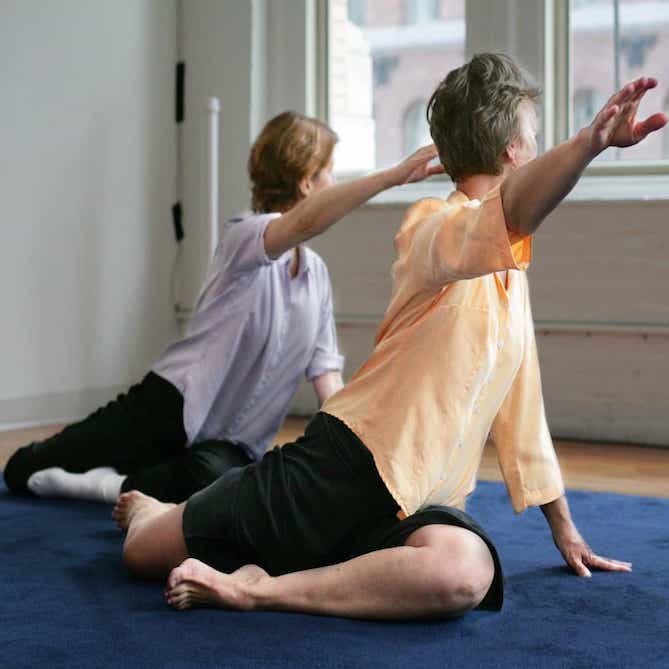
The Tools of Embodied Music® – the Feldenkrais Method® for Musicians (Part 2)
Aliza Stewart
The tools of Embodied Music® – the Feldenkrais Method® for Musicians:
1. Movement
2. Awareness
3. Reeducation of perception
4. Learning to change habits
5. Learning to use the whole self in playing
Movement
Dr. Feldenkrais used to say: “Movement is life. Without it, life is inconceivable. Improve your movement and you improve your life”. One can use the word “music” instead of “life” and the meaning will be as true. Playing an instrument is a succession of movements. The properties of movement are the properties of sound as well: time, space, weight, rhythmical impulse, gesture, momentum towards an action, the process of speeding gradually and slowing down gradually. Improving these properties in our movements will make it easier to achieve the sounds we want.
We derive meaning from music as we connect one sound to the next. The flow of the sounds as they relate to one another creates our sense of music. This flow must be mirrored in the movements we make when playing the music.
When the ease and efficiency are not experienced in the musician’s movement, two things happen – the brain does not have the appropriate image of the action needed for the musical gesture, and it cannot send the right impulses to the muscles. The action is then clumsy and can result in injuries.
The movement lessons and the private sessions are designed to make this an easy and pleasurable process.
Awareness
Dr. Feldenkrais repeated again and again that when we know what we are doing, we can do what we want. Faulty performance is the result of thinking we are doing one thing while in reality doing something else. Becoming aware means refining the ability to distinguish between what works and what doesn’t. Without awareness, practicing is simply inefficient. Learning to feel small differences in our movements takes a while, but it has the promise of changing the movement patterns in the original place where they were created – in the brain. Once we change these patterns, our spontaneous action will not be encumbered with inefficiency and unnecessary effort.
Becoming aware is one of the main goals of the movement lessons, whether in groups or in private sessions.
Here are two Embodies Music® experiments:
Playing by the seat of your pants
1. Please wear loose pants, especially in the area of the lower abdomen (which is the belly all the way to the pubic bone).
2. Take a chair with a flat, level seat and no arms. Ideally, the height should be at least the distance between the place where the heel touches the floor and the top of the knee.
3. Have the cello and bow on the floor next to you, within easy reach.
4. Sit on the edge of the chair, as if ready for playing. Can you feel that you are sitting on two bones, one in each buttock?
5. Lift your right buttock and put your palm, from behind, under the right sitting bone, then bring the buttock back to sit on your palm. The bone is round and one can be sitting directly on the most prominent part, or in the back of it, or in the front of it. Try to sit in all three ways, then find out what is most familiar to you.
6. Do the same on the left side.
7. Have both palms under both sitting bones. Lift the right buttock a bit and gently pull the right sitting bone with your hand a little bit backwards and bring it down on your palm. Stay at the new place while you do the same thing on the left side.
8. Now that you are sitting on both sitting bones, slowly slide your palms from under and take them out. Notice if you can feel the sitting bones better and if it changed you sitting.
9. Take the cello and play something you know well, without changing the placement of the sitting bones. Is there a difference in any aspect of your feelings and your sound? Don’t worry if you don’t feel a difference. It takes training to feel small differences!
The duck-pin bowling ball
1. Same position as in the previous experiment.
2. Take both of your sitting backwards like before and leave them there.
3. Imagine that a small (5”), but heavy, bowling ball is resting inside you, in the middle of your abdomen.
4. Take a slow, deep breath while sucking in your abdomen, as if to push the ball, with your guts, up into your chest. Then exhale and let it drop all the way down to the bottom of your pelvic floor, more of its weight in front. Do this 4 or 5 times.
5. Let the ball sit heavily down there, making sure your sitting bones are still pulled a bit back and your breathing is regular. Take time to feel all this.
6. Pick up the cello and play something you know well, without disturbing the resting of the ball and the breathing. Notice how your arms feel and whether the quality of the sound changed.
7. Continue playing with the ball resting securely in your abdomen and lift your eyes and your head to look up as much as you are comfortable with. Continue to play looking up. Are you aware of a change in the flow of the music?
If you are unclear about any of these instructions, please email me at alizastewart@gmail.com. I might not answer immediately, but I will get to it as soon as I can.
Subjects: Playing Healthy
Tags: Aliza, Awareness, cello, cellobello, Dr. Feldenkrais, gestures, improvement, Injuries, movement, movement lessons, music, perception, Stewart
